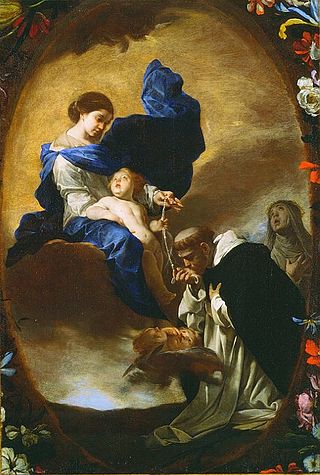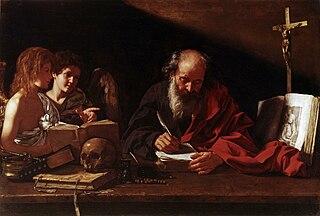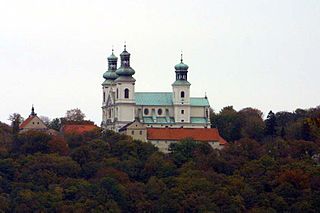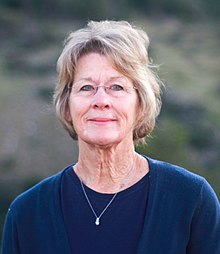
The Rosary, also known as the Dominican Rosary, refers to a set of prayers used primarily in the Catholic Church, and to the physical string of knots or beads used to count the component prayers. When referring to the prayer, the word is usually capitalized ; when referring to the prayer beads as an object, it is written with a lower-case initial letter.

Mary Flannery O'Connor was an American novelist, short story writer and essayist. She wrote two novels and 31 short stories, as well as a number of reviews and commentaries.

The Hail Mary or Angelical salutation is a traditional Christian prayer addressing Mary, the mother of Jesus. The prayer is based on two biblical passages featured in the Gospel of Luke: the Angel Gabriel's visit to Mary and Mary's subsequent visit to Elisabeth, the mother of John the Baptist. It is also called Angelical salutation as the prayer is based on the Archangel Gabriel's words to Mary. The Hail Mary is a prayer of praise for and of petition to Mary, regarded as the Theotokos. Since the 16th century, the version of the prayer used in the Catholic Church closes with an appeal for her intercession. The prayer takes different forms in various traditions and has often been set to music.

Penance is any act or a set of actions done out of repentance for sins committed, as well as an alternate name for the Catholic, Lutheran, Eastern Orthodox, and Oriental Orthodox sacrament of Reconciliation or Confession. It also plays a part in confession among Anglicans and Methodists, in which it is a rite, as well as among other Protestants. The word penance derives from Old French and Latin paenitentia, both of which derive from the same root meaning repentance, the desire to be forgiven. Penance and repentance, similar in their derivation and original sense, have come to symbolize conflicting views of the essence of repentance, arising from the controversy as to the respective merits of "faith" and "good works". Word derivations occur in many languages.

A hermit, also known as an eremite or solitary, is a person who lives in seclusion. Eremitism plays a role in a variety of religions.

The Camaldolese Hermits of Mount Corona, commonly called Camaldolese is a monastic order of Pontifical Right for men founded by Saint Romuald. Their name is derived from the Holy Hermitage of Camaldoli, high in the mountains of central Italy, near the city of Arezzo. Its members add the nominal letters E.C.M.C. after their names to indicate their membership in the congregation. Apart from the Roman Catholic congregations, ecumenical Christian hermitages with a Camaldolese spirituality have arisen as well.

Christian mysticism is the tradition of mystical practices and mystical theology within Christianity which "concerns the preparation [of the person] for, the consciousness of, and the effect of [...] a direct and transformative presence of God" or Divine love. Until the sixth century the practice of what is now called mysticism was referred to by the term contemplatio, c.q. theoria, from contemplatio, "looking at", "gazing at", "being aware of" God or the Divine. Christianity took up the use of both the Greek (theoria) and Latin terminology to describe various forms of prayer and the process of coming to know God.
Bernadette Roberts (1931–2017) was a former Carmelite nun and contemplative in the Catholic tradition.
Guideposts is a spiritual non-profit organization that encourages wellness through inspirational content creation. Founded in 1945 by Dr. Norman Vincent Peale, Raymond Thornburg, and Peale's wife, Ruth Stafford Peale with just one inaugural magazine, Guideposts has since grown to publish annual devotionals, books about faith, Christian fiction novels, five spiritual magazines, prayer content, as well as a content-rich website for daily inspiration. Guideposts has outreach programs to encourage wellness and help lifts the spirits of those in need – including military personnel, military families, support groups, hospitalized children, etc.

Philip Robert Cousineau is an American author, lecturer, independent scholar, screenwriter, and documentary filmmaker. He lives in San Francisco, California.

Dawn Eden Goldstein is an American Roman Catholic author, journalist, and songwriter. She was formerly a rock music historian and tabloid newspaper headline writer. Prior to 2016, she wrote under the pen name Dawn Eden.
Cyprian Consiglio, O.S.B. Cam., is an American composer, musician, Camaldolese monk and Catholic priest. He is noted for his musical work to support the practice of meditation. He is the author of two books.

A hermitage most authentically refers to a place where a hermit lives in seclusion from the world, or a building or settlement where a person or a group of people lived religiously, in seclusion. Particularly as a name or part of the name of properties its meaning is often imprecise, harking to a distant period of local history, components of the building material, or recalling any former sanctuary or holy place. Secondary churches or establishments run from a monastery were often called "hermitages".
New Camaldoli Hermitage is a rural Camaldolese Benedictine hermitage in the Santa Lucia Mountains of Big Sur, California, in the United States. The Camaldolese branch of the Benedictine family was founded by St. Romuald in the late 10th century. The hermitage was consecrated under the Immaculate Heart of Mary and was known by that name for its first decades, but its official name is New Camaldoli.

David Steindl-Rast OSB is an Austrian-American Catholic Benedictine monk, author, and lecturer. He is committed to interfaith dialogue and has dealt with the interaction between spirituality and science.

Desert Mothers is a neologism, coined in feminist theology as an analogy to Desert Fathers, for the ammas or female Christian ascetics living in the desert of Egypt, Palestine, and Syria in the 4th and 5th centuries AD. They typically lived in the monastic communities that began forming during that time, though sometimes they lived as hermits. Monastic communities acted collectively with limited outside relations with lay people. Some ascetics chose to venture into isolated locations to restrict relations with others, deepen spiritual connection, and other ascetic purposes. Other women from that era who influenced the early ascetic or monastic tradition while living outside the desert are also described as Desert Mothers.
Hubert van Zeller was a Benedictine writer, sculptor, and cartoonist, noted for writing about human suffering from a Catholic perspective.
Jon M. Sweeney is an author of popular history, spirituality, biography, poetry, fiction for young readers, and memoir. His most frequent subjects are Catholic, particularly St. Francis of Assisi, about whom Sweeney has written The St. Francis Prayer Book, Francis of Assisi in His Own Words, When Saint Francis Saved the Church, The Complete Francis of Assisi, and The Enthusiast, a biography that Richard Rohr calls "An immense and important contribution to our understanding of the great saint."

Stratford Caldecott was a Catholic author, editor, publisher, and blogger. His work spanned subjects as diverse as literature, education, theology, apologetics, economics, environmental stewardship, sacred geometry, art, and culture. His books include Secret Fire, Radiance of Being, Beauty for Truth's Sake, All Things Made New, and Not as the World Gives. He was a founding editor of the online journal Humanum and a contributor for several online and print journals. He was inspired by the Catholic author J. R. R. Tolkien and became known as a Tolkien scholar.













